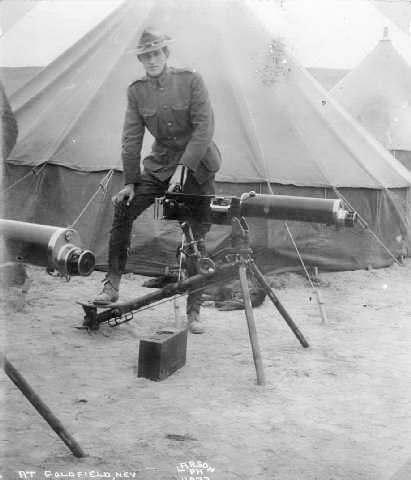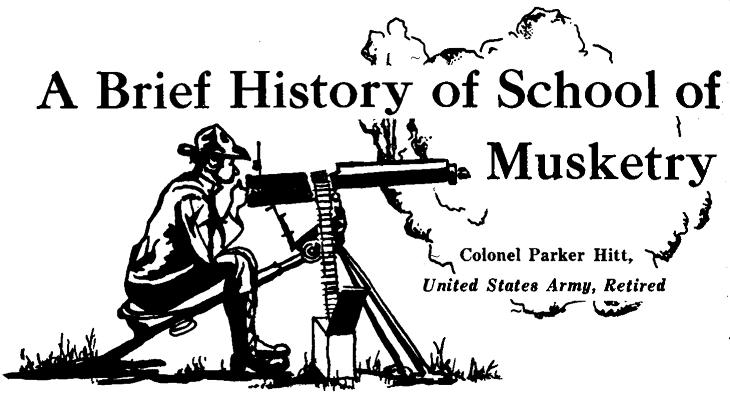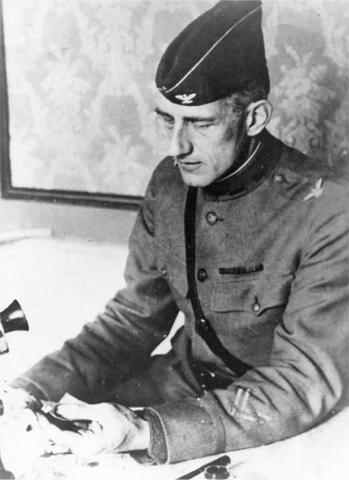![]() 1st Battalion 22nd Infantry
1st Battalion 22nd Infantry ![]()
22nd Infantry Machine Gun Platoon & School of Musketry
Parker Hitt served eleven years
with the 22nd Infantry. He saw combat with the Regiment
in the Philippines, and also was there for the 22nd's duty in
Alaska. He wrote the first manual on cryptology
for the US Military and retired from the Army as a Colonel. In
2011 he was added to the NSA's Hall of Honor.
In the following article,
written for the Military Review of the Army's Command and General
Staff College in 1961,
Hitt wrote his reminiscences of his early experiences with the
22nd Infantry's machine gun platoon, and the simultaneous
establishment of the Army's School of Musketry, in Monterey,
California. ¹
Photos, captions and comments added by the website editor.

1st LT Parker Hitt, seen here at
Goldfield, Nevada, in command of the machine gun platoon
of the 22nd Infantry. Hitt commanded the machine gun
platoon from November 1907 to June 1908,
and again from August to December of 1910.
Photo from the P.E. Larson Collection, courtesy
of the
Nevada State Museum, Carson City, Nevada
Nevada Department of Cultural Affairs

Colonel Parker Hitt was
retired from the United States Army in 1928 after 30 years of
service. He served as an instructor
at the School of Musketry at Monterey, California, from 1906 to
1908; at Fort Leavenworth from 1912 to 1915;
at the School of Musketry, Fort Sill, Oklahoma, from 1915 to
1917; and at the Army War College from 1919 to 1924.
He was a pioneer in the theory of machinegun employment.
The School of Musketry was
started at Monterey following one of the most significant
military developments in the history
of the United States Army. This was the issue of two Maxim
machineguns to each infantry and cavalry regiment in 1906.
I was a lieutenant in the 22d
Infantry, with battle experience in the Philippines with the
British one-pounder (pom-pom),
the Gatling and the Colt machinegun. In the fall of 1906 I was
placed in command of the provisional machinegun platoon
which was authorized for the regiment. ( Ed., Note: Hitt's memory
was tempered by 54 years. He was actually assigned to
command of the machine gun platoon in November 1907, not the fall
of 1906.)
The platoon had just moved from
Camp Lewis, Washington, to the Presidio of Monterey, California,
where it was assigned
for duty at the newly organized School of Musketry. Shortly
thereafter, the entire 22d Infantry was ordered to Goldfield,
Nevada, and the machinegun platoon went as an integral part of
the regiment. Not until February 1908, was the platoon
back in Monterey on duty with the School of Musketry. My account
of what followed consists mainly of personal
reminiscences; official records are sadly deficient for that
period.
|
The model of Maxim machine
gun as used by Note the seat for the gunner.
Photo from the |
The provisional machinegun
platoon was an orphan. It consisted of 18 privates, two
corporals, a sergeant, and a first
or second lieutenant. Owing to the type of regimental
organization fixed by Congress at that time, the enlisted men of
the
platoon actually were members of Companies A, B, and C of each
regiment. These companies were authorized an increase
of seven men each to provide for this innovation.
The platoon consisted of two
squads of a corporal and nine men each, a sergeant who acted as
first sergeant, a lieutenant
of the regiment in command, 10 pack mules, and pack equipment
designed for horses. Each squad had one gun weighing about
58 pounds and a tripod weighing about 52 pounds with tool, water,
and ammunition load totaling about 800 pounds.
(Ed., Note: Most accounts place the weight of the tripod at
closer to 80 pounds, not 52.)
The guns were fine. They were a
British development of the Boer War, which were not considered
heavy for those days.
The ammunition allowance was 500 rounds per gun per year,as fixed
by the Ordnance Department. Training manuals consisted
of a single copy of a book by the Vickers-Maxim Company on the
assembly and operation of the gun.
Assignment to Monterey
What an opportunity for a young
man! The assignment of a detached battalion, and the provisional
machinegun platoon
of the 22d Infantry to the School of Musketry at Monterey meant a
freedom of action for a subordinate commander
which is inconceivable under present conditions. I felt after a
few months at Monterey that no one knew more about
machineguns than I did. Any idea suggested by my men or by the
school was tested with ammunition expenditure
(if necessary) that wiped out the annual allowance in a few
minutes. Indirect fire, night firing, and improvised apparatus
were all played with.
The 20th Infantry was stationed
at Monterey at that time and some time in 1907, Company A of that
regiment was converted
into a three-platoon machinegun company. Colonel Marion P. Maus,
commanding the regiment, had assigned to him
to command Company A, Captain John H. (Gatling Gun) Parker of
Santiago fame. As lieutenants, the company had
Thomas W. Brown, Frank S. Bowen, and Leighton Powell each of whom
commanded a platoon of Maxim guns
identical with mine. This was a fine thing for local competition.
I well recollect a club
controversy which I had with Captain Parker over the relative
merits of the Gatling and Maxim guns.
It developed into an accuracy firing test in which two of my men
fired a new Benet-Mercier gun sent to the school for test;
the rest of my men fired two Maxims. Two picked squads of the
20th Infantry company fired two Gatling guns on artillery
mounts—
under Captain Parker's extremely personal supervision. Each gun
fired 100 rounds at an A target at 200 yards.
I do not remember the exact
scores but my Maxims put every shot in the four ring, the
Benet-Mercier put every shot
in the target, and the two Gatlings failed to account for about
50 of their 200 shots.
At Monterey I developed a
friendship and professional association with Lieutenant T. W.
Brown, which was continued
at Fort Sill in 1915. I considered Brown one of the greatest in
the machinegun game—a man of advanced ideas and yet one
who never let his ideas run wild. He and I carried on the cult of
the machinegun at the new School of Musketry at Fort Sill
in 1915-17—in the days when the Army had no machineguns,
when the Benet-Mercier automatic rifle was king, when war
was approaching. We fought to get classes of noncommissioned
officers to attend the school. No officers could be spared
for that kind of foolishness.
What would it mean to a company
commander in these days if the Department of the Army were to
direct that he work out
his own ideas for a set of drill regulations, firing regulations,
and field service regulations, and after a year's trial, submit
them
to the Department of the Army for consideration? This is
substantially what happened in 1906.
My predecessor had sound ideas
from the start. I do not remember making any recommendations for
change in his
provisional regulations, except in the firing regulations. And in
this case, I had reason. I have said that the ammunition
allowance
at that time was 500 rounds per gun per year. In the Fiscal Year
1907-08, I expended about 20,000 rounds per gun for my two guns
in every sort of experiment and test. Naturally, I saw the folly
and inadequacy of any such allowance as 500 rounds per gun.
I saw the need for more extended firing in machinegun training
and made rather extensive recommendations to the commandant
along this line. These recommendations were worked into the
1,000-inch firing course and the machinegun regulations
by Captain Brown and myself at Fort Still in 1916-17, some 10
years later.
No Machinegun Theory
The rifle was king in those days
and a man went to the School of Musketry to have his chance to
get in the Pacific Department
rifle competition. I fired in the 1907 competition where we had
the 40-round skirmish run and got a bronze medal with a score of
744.
The machinegun was a curiosity to the classes at the school. We
let each member of the class fire a few rounds, showed them
how to reduce jams, and had inspections of the platoon in field
equipment, but otherwise I can remember no classwork.
There was no theory of machineguns that had been put into print;
John Henry Parker was in the officers club any day
to tell all that was worth telling about their history.
Practically, the machineguns were complicated engines exploited
by
youthful cranks who expected them to dominate the battlefield of
the future.
There was a 600-yard range right
in the upper or school section of the post and the quarters of
the bachelor officers
ran close along one side between the 500- and 600-yard firing
points. A pistol range paralleled the main range,
the pits being continuous. The range was very well-equipped and
was used for the Pacific Division competitions
in 1907 and 1908.
Experiments of all kinds went on
there. I remember taking readings for a week on a transit set up
at the 600-yard
firing point and on thermometers and hygrometers to try to
determine some law for mirage. Night firing was tried there
both with machineguns and rifles. Captain F. G. Stritzinger, Jr.,
made 20 consecutive bull's-eyes at 500 yards one black night,
the aiming point being a lantern hung on the upper corner of the
target. (Ed., : from 1902 to 1911 CPT Frederick G. Stritzinger
commanded L Company 22nd Infantry.)
The first models of the Colt
pistol were tested there and I found a way to make the pistol go
off by juggling the safeties alone
without touching the trigger. Colonel Marion P. Maus, president
of the test board, was incredulous and on trying it for himself
the gun went off and the bullet chipped a neat nick in the toe of
his boot. (Ed., : Marion P. Maus was Lieutenant Colonel
of the 22nd Infantry from June 1902 to January 1904.)
First Drop Targets
I think I was responsible for
the first successful field targets used by the Army which would
fall when struck by a bullet
and yet stand in a wind. I made several models at Monterey,
including a rotary one which turned over automatically
when struck, exposing a fresh target. The drop targets were
afterward taken up by the Ordnance Department,
which manufactured them for a time.
One fault of the water-cooled
Maxims was that after firing several hundred rounds continuously
they began to steam.
The steam came up in a beautiful white plume from two to five
feet high, exposing the gun and often cutting off the line of
sight
as well. It was as if we had hung out a sign, "Here is a
machinegun." The British had this trouble during the Boer
War
but nobody devised a remedy for it.
One day this happened in some
test firing at the 500-yard firing point in front of my quarters
and I got a piece of rubber tubing
out of my bathroom and inserted one end in the steam vent and the
other into a water box on the ground. The tube
did the trick of eliminating the steam at once. Later we made a
metal nozzle with a holding-on catch and used this device for all
firings.
I recommended the device to the War Department by letter in March
1908. The reply came in a typical official letter of those days.
WAR DEPARTMENT
Office of the Chief of Ordnance
Washington
38356-841
BSq July 30, 1909
The Adjutant General,
U.S.Army
Sir:-
1. I have the honor to invite
attention to letter of 1st, Lieut. Parker Hitt, 22nd
Infantry,-commanding the machine gun platoon
at the Presidio of Monterey, California, dated March 23, 1908,
A.G.O. 1360437—(0.0.38356-537), wherein he recommends
a device intended to do away with the steam that sometimes issues
from the water-jacket of Maxim automatic machine guns.
2. Extensive tests of this
device have been conducted by the Ordnance Board at the Sandy
Hook Proving Ground
under instructions from this office. It was found that the device
accomplishes the purpose for which it was designed
within certain limits, viz: up to the point where it becomes
necessary to refill the water-jacket. If then the tube which
leads
to the water box on the ground be not disconnected, the time
required for the pressure in the water-jacket to fall
sufficiently
to permit filling is quite considerable; and if the tube be
removed for each filling, a cloud of steam issues from the jacket
and the time required until firing can be resumed is still
appreciably greater than if the tube is not used, being in the
tests made
from 20 to 56 seconds longer.
3. In the firings made at the
proving grounds no difficulty was encountered in sighting due to
the steam either with
or without the tube, but this is largely a question of
atmospheric conditions at the time. Observers were placed with
telescopes
at distances of 1,000 yards and 2,300 yards during the firing. At
2,300 yards no steam was visible either with or without the tube.
At 1,000 and 1,200 yards the steam was visible from the gun
without the tube and also, during the filling period only,
from the gun with the tube.
4. The visibility of the steam
would, of course, be a factor only in cases where practically
complete cover for the gun
and crew were obtainable, since the latter would be much more
noticeable than the steam.
5. The question of the
advisability of furnishing the attachment proposed is, therefore,
one of the relative importance
of being free from any obstruction of the line of sight by steam,
which should normally be only an occasional difficulty,
and of having the location of the gun in those cases where the
men and equipment are concealed indicated by steam
about once in every 750 rounds instead of continuously as
compared with the disadvantage of the extra time for filling,
the additional cost and the inconvenience of carrying. As the
inconvenience of the extra equipment is slight; as the extra cost
is inconsiderable, and as the disadvantage of having the line of
sight continuously blurred, even on exceptional occasions,
is great, the attachment will be supplied for all machine guns.
6. The original papers have been retained for use in connection with manufacture.
7. It is suggested that this letter be referred to Lt. Hitt and to the Commandant of the School of Musketry.
Very respectfully,
(Sgd) William Crozier.
Brig. Genl., Chief of Ordnance.
It was said that the British and
German military attaches saw the test at Sandy Hook and that the
British and German Armies
were equipped with these tubes in the fall of 1909, while we
wandered off to the Benet-Mercier air-cooled automatic rifle
and never did get the steam tubes until the Browning came in
1918.

Machine Gun Squad, Company B, Second
U.S. Infantry. The leather strap hanging arrangement for the
steam condensing hose can be seen.
Underneath the gun the strap had a chain and hook to hold the
hose and give it slack, to prevent it from binding when the gun
was traversed.
The steam condensing hose was a modification invented by Parker
Hitt while he was with the 22nd Infantry. It was used not only on
the Maxim gun
as shown in the above photo, but also on the Browning guns which
came into service later. The boxes in the photo with the white
stripe painted
on them are water boxes. The boxes without the stripe are
ammunition boxes. Both boxes were made of wood and were the same
size.
Photo from the Small Arms Defense journal
There is one last story which
does not really belong to Monterey but which shows the attitude
of the Army
to the machinegun in those days. In May 1908 orders came for the
22d Infantry to go to six stations in Alaska for a two-year tour.
The machinegun platoon was to go with regimental headquarters to
Fort Seward and I was given command of I Company
to go to Nome. The colonel, a fine gentleman of the old school,
saw two long winters ahead and picked his official family
with care. There were, I believe, no bachelors in his garrison
and my successor, Lieutenant W. G. Doane, joined on the dock
at San Francisco with his wife after a four-year detail in the
Judge Advocate General's Department. A year later,
the Department Inspector found the machine-guns and equipment
packed in their original shipping boxes. The platoon
was on "special duty" about the post. The transport
gathered the regiment together again in July 1910 and on board
we got word that we were to go on maneuvers at Leon Springs as
soon as we reached Fort Sam Houston. My good friend
George S. Simonds, then regimental -adjutant, told me the colonel
wanted me to take the platoon again and get it in shape
for the maneuvers. "What is left of it?" I asked,
thinking of what was the finest, best trained machinegun platoon
in the Army
two years ago. "The equipment, one corporal, and one
private," he replied.

Colonel Parker Hitt, as Chief Signal
Officer, 1st Army,
American Expeditionary Forces, France, 1918.
Photo from the National Archives, 111-SC-23349
¹ Military Review, U.S. Army Command and General Staff College, Fort Leavenworth, Kansas, Volume XLI July 1961 Number 7
Home | Photos | Battles & History | Current |
Rosters & Reports | Medal of Honor | Killed
in Action |
Personnel Locator | Commanders | Station
List | Campaigns |
Honors | Insignia & Memorabilia | 4-42
Artillery | Taps |
What's New | Editorial | Links |